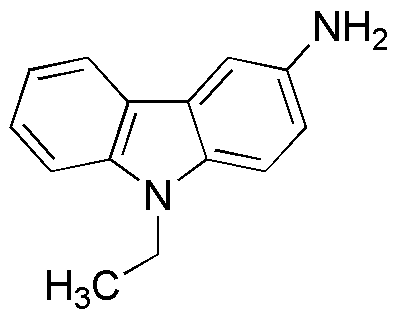3-Amino-9-ethylcarbazole is widely utilized in research focused on:
- Biological Staining: This compound is commonly used as a chromogenic substrate in histochemistry, allowing researchers to visualize specific proteins in tissue samples, enhancing the clarity of biological studies.
- Polymer Chemistry: It serves as a building block in the synthesis of various polymers, particularly in creating conductive materials, which are essential for developing advanced electronic devices.
- Pharmaceutical Development: The compound is explored for its potential in drug formulation, particularly in the development of anti-cancer agents, due to its ability to interact with biological targets effectively.
- Organic Electronics: Its properties make it suitable for use in organic light-emitting diodes (OLEDs), contributing to the production of energy-efficient lighting and display technologies.
- Research in Photovoltaics: The compound is investigated for its role in enhancing the efficiency of solar cells, providing a pathway for more sustainable energy solutions.
General Information
Properties
Safety and Regulations
Applications
3-Amino-9-ethylcarbazole is widely utilized in research focused on:
- Biological Staining: This compound is commonly used as a chromogenic substrate in histochemistry, allowing researchers to visualize specific proteins in tissue samples, enhancing the clarity of biological studies.
- Polymer Chemistry: It serves as a building block in the synthesis of various polymers, particularly in creating conductive materials, which are essential for developing advanced electronic devices.
- Pharmaceutical Development: The compound is explored for its potential in drug formulation, particularly in the development of anti-cancer agents, due to its ability to interact with biological targets effectively.
- Organic Electronics: Its properties make it suitable for use in organic light-emitting diodes (OLEDs), contributing to the production of energy-efficient lighting and display technologies.
- Research in Photovoltaics: The compound is investigated for its role in enhancing the efficiency of solar cells, providing a pathway for more sustainable energy solutions.
Documents
Safety Data Sheets (SDS)
The SDS provides comprehensive safety information on handling, storage, and disposal of the product.
Product Specification (PS)
The PS provides a comprehensive breakdown of the product’s properties, including chemical composition, physical state, purity, and storage requirements. It also details acceptable quality ranges and the product's intended applications.
Certificates of Analysis (COA)
Search for Certificates of Analysis (COA) by entering the products Lot Number. Lot and Batch Numbers can be found on a product’s label following the words ‘Lot’ or ‘Batch’.
Numéro de catalogue
Numéro de lot/série
Certificates Of Origin (COO)
This COO confirms the country where the product was manufactured, and also details the materials and components used in it and whether it is derived from natural, synthetic, or other specific sources. This certificate may be required for customs, trade, and regulatory compliance.
Numéro de catalogue
Numéro de lot/série
Safety Data Sheets (SDS)
The SDS provides comprehensive safety information on handling, storage, and disposal of the product.
DownloadProduct Specification (PS)
The PS provides a comprehensive breakdown of the product’s properties, including chemical composition, physical state, purity, and storage requirements. It also details acceptable quality ranges and the product's intended applications.
DownloadCertificates of Analysis (COA)
Search for Certificates of Analysis (COA) by entering the products Lot Number. Lot and Batch Numbers can be found on a product’s label following the words ‘Lot’ or ‘Batch’.
Numéro de catalogue
Numéro de lot/série
Certificates Of Origin (COO)
This COO confirms the country where the product was manufactured, and also details the materials and components used in it and whether it is derived from natural, synthetic, or other specific sources. This certificate may be required for customs, trade, and regulatory compliance.


